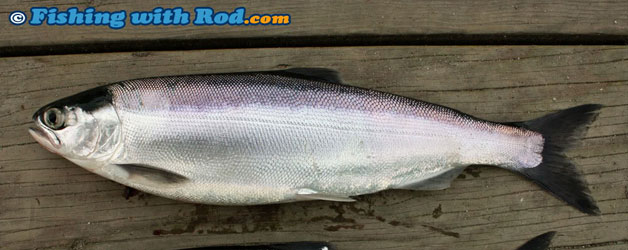Kokanee
Oncorhynchus nerka

No, not the beer, but a tiny salmonid species that has been caged within inland waters since the last glacial period. A kokanee is a landlocked sockeye salmon. Although they share the same scientific name with their saltwater cousins, they are significantly smaller as the amount of their feed is less.
Description
Beside the size difference, kokanee are very similar to sockeye salmon. Average size of kokanee is between 10 and 14 inches, but it is not uncommon to encounter fish up to 2 to 3lb in some lakes. Their body is silver, with a straight lateral line. No distinct spots can be found on their body unlike other salmon species. Their body is not deep. Males' dorsal region becomes thicker during spawning period.
Distribution
Kokanee can be found in Alaska, Yukon, British Columbia and parts of Washington and Oregon.
Life History
Kokanee reside in lake-stream systems. Each population, unless introduced, is the evolutionary product of a sockeye population, bounded by land after the last glacial period. Kokanee spawn in late summer and fall in streams. Juvenile kokanee spend their early days feeding in shallow portions of the lake. Adults cruise in different depths of the lake depending on the time of the year. Kokanee mainly feed on plankton, but aquatic insect can also be part of their diet.
Fishing Locations
Many coastal and interior lakes across British Columbia offer good kokanee fishing. In the Lower Mainland, Kawkawa Lake and Alouette Lake are two main kokanee fisheries. In the Okanagan region, kokanee fisheries have made a healthy comeback in Okanagan Lake and other nearby lakes. The Freshwater Fisheries Society of BC has been developing new fisheries in this province where triploid kokanee are stocked. It is important to check the freshwater regulation synopsis for the opening and closing times of this fishery.
Fishing Techniques
Kokanee can be caught by bait, trolling or flyfishing. Small flies such as chironomid work well, while krill or shrimp can be deadly. Whichever method you decide to use, it is important to remember to fish where the school is. Kokanee travel at different depths based on the time of the year. In early spring, spotting them on the surface with a boat and casting in front of the school can be productive. In late spring and summer, the fish tend to hold in deeper water. Enticing them to bite is easy, but keeping them on the hook can be tough as kokanee dart, dive, leap at incredibly fast speed.
